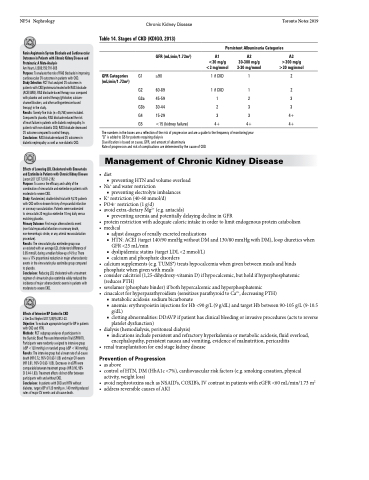Page 734 - TNFlipTest
P. 734
NP34 Nephrology
Chronic Kidney Disease
Toronto Notes 2019
Table 14. Stages of CKD (KDIGO, 2013)
Renin Angiotensin System Blockade and Cardiovascular Outcomes in Patients with Chronic Kidney Disease and Proteinuria: A Meta-Analysis
Am Heart J 2008;155:791-805
Purpose: To evaluate the role of RAS blockade in improving cardiovascular CV outcomes in patients with CKD.
Study Selection: RCT that analyzed CV outcomes in patients with CKD/proteinuria treated with RAS blockade (ACEI/ARB). RAS blockade-based therapy was compared with placebo and control therapy (β-blocker, calcium- channel blockers, and other antihypertensive-based therapy) in the study.
Results: Twenty-five trials (n=45,758) were included. Compared to placebo, RAS blockade reduced the risk
of heart failure in patients with diabetic nephropathy. In patients with non-diabetic CKD, RAS blockade decreased CV outcome compared to control therapy.
Conclusions: RAS blockade reduced CV outcomes in diabetic nephropathy as well as non-diabetic CKD.
Effects of Lowering LDL Cholesterol with Simvastatin and Ezetimibe in Patients with Chronic Kidney Disease Lancet 2011;377:2181-2192
Purpose: To assess the efficacy and safety of the combination of simvastatin and ezetimibe in patients with moderate to severe CKD.
Study: Randomized, double-blind trial with 9,270 patients with CKD with no known history of myocardial infarction or coronary vascularization. Patients were randomized
to simvastatin 20 mg plus ezetimibe 10 mg daily versus matching placebo.
Primary Outcome: First major atherosclerotic event (non-fatal myocardial infarction or coronary death, non-hemorrhagic stroke, or any arterial revascularization procedure).
Results: The simvastatin plus ezetimibe group was associated with an average LDL cholesterol difference of 0.85 mmol/L during a median follow-up of 4.9 yr. There was a 17% proportional reduction in major atherosclerotic events in the simvastatin plus ezetimibe group compared to placebo.
Conclusions: Reducing LDL cholesterol with a treatment regimen of simvastatin plus ezetimibe safely reduced the incidence of major atherosclerotic events in patients with moderate to severe CKD.
Effects of Intensive BP Control in CKD
J Am Soc Nephrol 2017;28(9):2812-23.
Objective: To evaluate appropriate target for BP in patients with CKD and HTN.
Methods: RCT subgroup analyses of participants in
the Systolic Blood Pressure Intervention Trial (SPRINT). Participants were randomly assigned to intensive group (sBP <120 mmHg) or standard group (sBP <140 mmHg). Results: The intensive group had a lower rate of all-cause death (HR 0.72, 95% CI 0.63-1.05) and major CV events (HR 0.81, 95% CI 0.63-1.05). Decreases in eGFR were comparable between treatment groups (HR 0.90, 95%
CI 0.44-1.83). Treatment effects did not differ between participants with and without CKD.
Conclusions: In patients with CKD and HTN without diabetes, target sBP of 120 mmHg vs. 140 mmHg reduced rates of major CV events and all-cause death.
GFR (mL/min/1.73m2)
G5 <15 (kidney failure) 4+ 4+
GFR Categories (mL/min/1.73m2)
G1 ≥90 G2 60-89
A1 <30 mg/g <3 mg/mmol
A2 30-300 mg/g 3-30 mg/mmol
A3 >300 mg/g >30 mg/mmol
2
2 3 3 4+ 4+
Persistent Albuminuria Categories
1 if CKD 1
1 if CKD 1 G3a45-59 1 2 G3b 30-44 2 3 G415-29 3 3
The numbers in the boxes are a reflection of the risk of progression and are a guide to the frequency of monitoring/year “D” is added to G5 for patients requiring dialysis
Classification is based on cause, GFR, and amount of albuminuria
Rate of progression and risk of complications are determined by the cause of CKD
Management of Chronic Kidney Disease
• diet
■ preventing HTN and volume overload
• Na+ and water restriction
■ preventing electrolyte imbalances
• K+ restriction (40-60 mmol/d)
• PO43– restriction (1 g/d)
• avoid extra-dietary Mg2+ (e.g. antacids)
■ preventing uremia and potentially delaying decline in GFR
• proteinrestrictionwithadequatecaloricintakeinordertolimitendogenousproteincatabolism • medical
■ adjust dosages of renally excreted medications
■ HTN: ACEI (target 140/90 mmHg without DM and 130/80 mmHg with DM), loop diuretics when
GFR <25 mL/min
■ dyslipidemia: statins (target LDL <2 mmol/L) ■ calciumandphosphatedisorders
• calcium supplements (e.g. TUMS®) treats hypocalcemia when given between meals and binds phosphate when given with meals
• considercalcitriol(1,25-dihydroxy-vitaminD)ifhypocalcemic,butholdifhyperphosphatemic (reduces PTH)
• sevelamer (phosphate binder) if both hypercalcemic and hyperphosphatemic
• cinacalcetforhyperparathyroidism(sensitizesparathyroidtoCa2+,decreasingPTH)
■ metabolic acidosis: sodium bicarbonate
■ anemia: erythropoietin injections for Hb <90 g/L (9 g/dL) and target Hb between 90-105 g/L (9-10.5
g/dL)
■ clotting abnormalities: DDAVP if patient has clinical bleeding or invasive procedures (acts to reverse
platelet dysfunction)
• dialysis(hemodialysis,peritonealdialysis)
■ indications include persistent and refractory hyperkalemia or metabolic acidosis, fluid overload, encephalopathy, persistent nausea and vomiting, evidence of malnutrition, pericarditis
• renaltransplantationforendstagekidneydisease
Prevention of Progression
• asabove
• controlofHTN,DM(HbA1c<7%),cardiovascularriskfactors(e.g.smokingcessation,physical
activity, weight loss)
• avoid nephrotoxins such as NSAID’s, COXIB’s, IV contrast in patients with eGFR <60 mL/min/1.73 m2 • addressreversiblecausesofAKI


